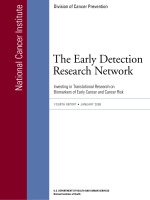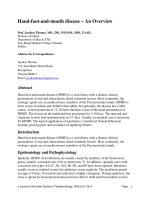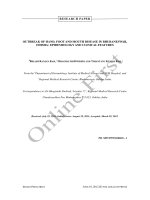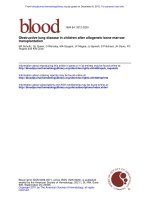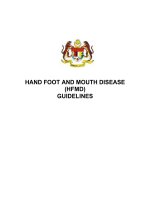OUTBREAK OF HAND, FOOT AND MOUTH DISEASE IN BHUBANESWAR, ODISHA: EPIDEMIOLOGY AND CLINICAL FEATURES doc
Bạn đang xem bản rút gọn của tài liệu. Xem và tải ngay bản đầy đủ của tài liệu tại đây (200.03 KB, 9 trang )
INDIAN PEDIATRICS JUNE 10, 2012 [E-PUB AHEAD OF PRINT]
RESEARCH PAPER
OUTBREAK OF HAND, FOOT AND MOUTH DISEASE IN BHUBANESWAR,
ODISHA: EPIDEMIOLOGY AND CLINICAL FEATURES
#
BIKASH RANJAN KAR, * BHAGIRATHI DWIBEDI AND *SHANTANU KUMAR KAR
From the
#
Department of Dermatology, Institute of Medical Science and SUM Hospital; and
*
Regional Medical Research Centre; Bhubaneswar, Odisha, India.
Correspondence to: Dr Bhagirathi Dwibedi, Scientist ‘C’, Regional Medical Research Centre,
Chandrasekhar Pur, Bhubaneswar 751 023, Odisha, India
Received: July 22, 2011; Initial review: August 29, 2011; Accepted: March 29, 2012.
PII: S097475591100618 – 1
KAR, et al. HAND, FOOT AND MOUTH DISEASE
INDIAN PEDIATRICS JUNE 10, 2012 [E-PUB AHEAD OF PRINT]
ABSTRACT
Objective: To describe the epidemiology and clinical features of cases in a outbreak of Hand,
Foot and Mouth Disease (HFMD)
Design: Descriptive epidemiological study
Setting: Hospitals and community in urban areas of Bhubaneswar city, Odisha.
Methods: Upon clinical suspicion of the first case as HFMD, local pediatricians and
dermatologists were sensitized for case referral to Dermatology department of Institute of
Medical Science and SUM hospital (IMS&SH) for evaluation and follow up. Community
survey was undertaken by household visit by the team from Regional Medical Research
Centre, Bhubaneswar in an outbreak area through hospital case tracing. Blood samples were
tested for haematological counts and RT PCR assay done in a subset of samples for
confirmation.
Results: Seventy eight cases of HFMD were detected between September 7 and November 6,
2009. Mean age (SD) was 5.13 (4.94) years (range 4 mo – 31 yrs) and both sexes were
equally affected. Fever and rash were the most common presenting symptoms with the rash
distributed mostly over buttocks (83.3%), knees (77.5%), both surfaces of hands and oral
mucosa (78.2%). Lesions healed in 7 – 15 (Mean SD 8.6 (1.5) days. Recovery was complete
with minimal supportive treatment but, nail shedding was noted in three children within 4- 5
weeks. CA16 was confirmed as the viral agent.
Conclusion: Children (5-14 yrs) were majorly affected and complete recovery without
neurological complications were noted. The characteristic clinical features described will be
useful for early clinical diagnosis where laboratory confirmation is not feasible.
Key words: Coxsackie A 16, Enterovirus 71, Epidemic, atopy, Hand foot and mouth disease.
First diagnosed in a child suffering from encephalitis in California in 1969 [1]. Hand, foot,
mouth disease (HFMD) is caused by different types of Enteroviruses. CA16 and EV71 were
reported as the major enterovirus types where as A4, A5, A8, A10, B3 and B7 act as the minor
etiological agent causing
HFMD [2].
Clinically, the condition is characterized by a combination of exanthems and
enanthems. Reports from Asia-pacific region indicated occurrence of epidemics in 1997
(Sarawak) [3], 1998 (Taiwan) [4], 1999 (Perth) [5] and 2000 (Singapore, Korea, Malaysia and
Taiwan) [6]. The first epidemic from India was reported from Kerala in 2003 [7]. The others
were reported from Nagpur in 2005-06 [8] and West Bengal in 2007 [9]. HFMD was reported
for the first time from state of Orissa (presently renamed as Odisha) in 2009 [10]. The clinical
KAR, et al. HAND, FOOT AND MOUTH DISEASE
INDIAN PEDIATRICS JUNE 10, 2012 [E-PUB AHEAD OF PRINT]
presentation and demography of the affected population in the above outbreak are described
herein.
M
ETHODS
The first suspected case was identified in the Dermatology outpatient department of
IMS&SH, Bhubaneswar on 7September, 2009. After clinical diagnosis of the case as HFMD,
pediatricians and dermatologists serving in clinics and hospitals of Bhubaneswar were
sensitized and requested to refer all the suspected cases to the Department for clinical
evaluation. Sensitization was done through presentations about the case and importance of
investigation in seminars and meetings organized by the local physician associations.
Besides case enrollment in the above hospitals, community survey was undertaken by
an epidemic investigation team from Regional Medical Research Centre, Bhubaneswar by
visiting the households in an affected urban location. Cases were examined and extent of
involvement was recorded. Detailed history was collected from the suspected patients that
included contact history in the family or neighbours. Symptoms and signs were recorded in a
structured format, after clinical examination. Stool, urine and blood samples (3-4 ml) were
collected from subjects for investigation.
Routine blood examinations including complete blood count, Erythrocyte
sedimentation rate, urine routine and microscopy and stool routine and microscopy were done
in all cases. Histopathology was not done in any of the cases. Laboratory confirmation of the
suspected viral etiology was carried out on a subset of serum samples (n=7). The samples
were stored at -70
0
C in the laboratory of Regional Medical Research Centre, Bhubaneswar
and subsequently transported in cold chain and tested at National Institute of Virology, Pune
by molecular diagnostics [10].
R
ESULTS
The first clinically suspected case was a 15 month old female child from Rasulgarh area of
Bhubaneswar, who presented with fever of 1 day duration associated with sore throat, oral
ulcers and irritability. Papulovesicular lesions were distributed over the buttocks, legs, hands
and in the perioral area. A total of 78 cases were recorded till November 6, 2009 and out of
them 46 were followed up till recovery. The patients belonged to four urban locations, namely
Rasulgarh (16 cases), Nayapalli (22 cases), Sahid Nagar (15 cases) and Dumduma (25 cases)
under Bhubaneswar municipal corporation. One affected urban area (Nayapalli) was
investigated by household visit, and survey was undertaken in 48 households covering 250
individuals, and recorded 9 cases of suspected HFMD. A typical index case in the area was
not identified. However, household spread was evidenced by two cases from one family.
Age of the subjects ranged from 4 months to 31 years (Mean (SD) 5.13 (4.94) years, 42
males). Most of the cases were preschool or early school going children (Table I). Fever
KAR, et al. HAND, FOOT AND MOUTH DISEASE
INDIAN PEDIATRICS JUNE 10, 2012 [E-PUB AHEAD OF PRINT]
(74.3%) with rash (100%) were the most common presenting symptom along with associated
features like anorexia, irritability etc. The disease started as small (1-3mm) erythematous
maculopapular rash that rapidly enlarged and progressed to papulovescicular lesions with a
prominent erythematous halo. Most of the lesions turned to gray vesicles in 2-3 days time.
The lesions had a characteristic distribution with involvement of buttocks (Fig. I),
knees, hands and feet. Buttocks were the most severely and commonly affected sites in
majority (83.3 %) of patients followed by the knees (77.5 %). In very few cases, wrist, ankle
area and trunk were involved. In the hands, vesicles were more pronounced over the dorsal
aspect (Fig. 2) but papulovesicluar lesions were more on the palmar side. Lesions were
localised to margins of fingers, hands, thenar and hypothenar eminences and dorsal surfaces
than the volar aspect. Full blown vesicles were more common on the dorsal aspect.
Secondary infection and impetigenization of the lesions were observed in 11 cases.
The lesions were associated with itching in 24 cases which was more pronounced during the
healing phase. In the 46 cases having complete follow-up, average healing time was 8.6 days
(SD 1.6 days). Healing was uneventful except post inflammatory hypo and hyper-
pigmentation. Three patients had shedding of nails 4-5 weeks after recovery from the acute
symptoms.
Oral lesions were found in 61 (78.2%) cases. Sites involved were inner aspect of the
lips, gums, buccal mucosa, tongue and the hard palate. Small aphthous like lesions measuring
1 to 3 mm were the usual mucosal presentation. Most common systemic symptoms (Table II)
were fever and anorexia. History of mild fever either preceding to or simultaneously with the
eruption was present in 58 (74.3%) cases. Fever appeared on the same day in 70% cases and 1
day before onset of rash in 30% cases. Fever persisted for 1 to 2 days following onset. Sore
throat was a symptom during the prodrome or on the first day in 38 (48.7%) patients. Malaise
was also a dominant complain amongst 41 (52.5%) cases. Nine patients (11.5%) had a typical
viral prodrome comprising of fever, sorethroat and malaise.
Anorexia was a presenting feature in 35 (44.1%) patients. The presence of oral ulcers
might have contributed towards the manifestation of anorexia. Irritability was a predominant
clinical presentation in 21(26.9%) patients. Mostly infants and young children presented with
irritability.
Personal history of atopy was present in 22 (28.2%) patients and family history of
atopy was recorded in 35(44.8%) patients, while 18 (12.8%) patients had both. Patients with
personal history of atopy were more significantly associated with sorethroat compared to non-
atopics (P=0.01). Average lesion healing time in patients with both personal and family
history of atopy vs non-atopics was 10.13 (SD 1.25) days vs. 7.27 (SD 0.65) days.
Blood counts were within normal range in most cases except, three cases showing
KAR, et al. HAND, FOOT AND MOUTH DISEASE
INDIAN PEDIATRICS JUNE 10, 2012 [E-PUB AHEAD OF PRINT]
eosinophilia and two cases with neutrophilia. Routine and microscopic examination of stool
and urine samples did not reveal any abnormality. CA16 virus was identified as the causative
agent for the outbreak [10].
Most patients were managed conservatively with topical antibiotics, oral
antihistamines and antipyretics. Oral antibiotics were rarely required, i.e. only in two patients
because of secondary impetigenization. All the subjects recovered with the above treatment.
D
ISCUSSION
EV71 and CA16 viruses belong to picornaviridae family of genus Enterovirus. They have
single positive -strand genomic RNA with high mutation rate. Due to presence of multiple
genotypes and sub genotypes of the two viruses, repeated epidemics of HFMD have occurred
and others are expected in future. An outbreak is usually followed by a quiescent phase of few
years. Like all other enteroviruses, children are the most significant target as well as
reservoirs. Feco-oral route is the principal mode of transmission.
Diagnosis in most cases can be made from clinical presentation with certainty; if the
clinician has a strong suspicion. Differentials include papular urticaria, chickenpox, mosquito
bite etc. Rarity of cases and lack of suspicion as well as uneventful recovery are the most
important causes of missing a case clinically. Though laboratory confirmation depends on
direct isolation of virus in cell cultures, Indirect fluorescent assays (IFA), RT-PCR or serum
neutralization techniques are also useful. Clinical presentation is quite characteristic to raise
the suspicion of the condition and remains the sole diagnostic modality in resource
constrained areas. Previous outbreaks in Kerala and West Bengal also showed predominant
affliction of children [7,9] during the outbreak, there were two adults affected with the
disease during the outbreak. The disease in these two adults was similar to the affected
children. There was no statistically significant gender difference in disease. We found a
significant association between the severity as well as healing time of the disease with either
personal or family history of atopic diseases. Though the incidence of EV71 isolation from
HFMD outbreaks is on the higher side in various reports [2-6], CA 16 was confirmed to be
the viral agent in this outbreak. Follow up after healing of the lesions had revealed shedding
of nail in three patients, which is a rare observation.
The report is important, as the large rural especially tribal population base with lack
of general hygiene and water sanitation practices in Odisha can facilitate the spread of the
disease [10]. The randomness of the epidemic and unequal time gap between epidemics also
suggest possibilities of multiple such events in the coming years. The present report is
expected to increase the awareness amongst the practitioners regarding the clinical
presentation and benign and self-limiting nature of the presented HFMD cases. This will be
helpful for early clinical diagnosis and case management, thereby supporting public health
KAR, et al. HAND, FOOT AND MOUTH DISEASE
INDIAN PEDIATRICS JUNE 10, 2012 [E-PUB AHEAD OF PRINT]
measures, during future episodes if any.
What is already Known?
Enteroviruses like CA16 and EV71 are known to cause HFMD outbreaks; but, many
cases remain undiagnosed.
What This Study Adds?
The study described the clinical features of HFMD mostly in children, which will be
helpful for early clinical diagnosis and case management.
Acknowledgements: We are grateful to Dr V Gopalkrishna and Dr Shoba D Chitambar of the
National Institute of Virology, Pune for providing laboratory support and help in investigating
the disease. We are also thankful to Dr A Mohapatra, Dr B Mishra, Dr D Das, Dr A Jena and
Dr A Patra for referring cases to the hospital.
Contributors: BRK:
Enrollment of cases in hospital, clinical examination and recording, data
interpretation and manuscript preparation; BD:
Field investigation, Clinical examination and
recording, data interpretation, study design and manuscript preparation; SKK:
study design,
supervision and coordination, data interpretation and manuscript preparation
Funding: Indian Council of Medical Research, Dept. of Health Research, Ministry of Health
and Family Welfare, Govt. of India.
Competing interests: None stated.
KAR, et al. HAND, FOOT AND MOUTH DISEASE
INDIAN PEDIATRICS JUNE 10, 2012 [E-PUB AHEAD OF PRINT]
REFERENCES
1. Robinson CR, Doane FW, Rhodes AJ. Report of an outbreak of febrile illness with
pharyngeal lesions and exanthem: Toronto, summer 1957; isolation of group A Coxsackie
virus. Can Med Assoc J. 1958;79:615-21.
2. Li L He Y, Yang H, Zhu J, Xu X, Dong J, Zhu Y, et al. Genetic characteristic of human
Enterovirus 71 and Coxsackie virus A16 circulating from 1999 to 2004 in Shenzhen, Peoples’
Republic of China. J Clinical Microbiol. 2005;43:3835-9.
3. Podin Y, Gias EL, Ong F, Leong YW, Yee SF, Yusof MA, et al. Sentinel surveillance for
human Enterovirus 71 in Sarawak, Malaysia: Lessons from the first 7 years. BMC Public
Health. 2006;6:180.
4. Ho M, Chen ER, Hsu KH, Twu SJ, Chen KT, Tsai SF, et al. An epidemic of enterovirus 71
infection in Taiwan. N Engl J Med. 1999;341:929-35.
5. McMinn P, Stratov I, Nagarajan L, Davis S. Neurological manifestations of enterovirus
71 infection in children during an outbreak of Hand, Foot, and Mouth disease in Western
Australia. Clin Infect Dis. 2001;32:236-42.
6. Cardosa MJ, Perera D, Brown BA, Cheon D, Chan HM, Chan KP, et al. Molecular
epidemiology of human enterovirus 71 strains and recent outbreaks in the Asia-Pacific region:
Comparative analysis of the VP1 and VP4 Genes. Emerg Infect Dis. 2003;9:462-8.
7. Sasidharan CK, Sugathan P, Agarwal R, Khare S, Lal S, Jayaram Paniker CK. Hand, foot
and mouth disease in Calicut. Indian J Pediatrics. 2005;72:17-21.
8. Saoji VA. Hand, foot and mouth disease in Nagpur. Indian J Dermatol Venereol Leprol.
2008;74:133-5.
9. Sarma N, Sarkar A, Mukherjee A, Ghosh A, Dhar S, Malakar R. Epidemic of hand, foot
and mouth disease in West Bengal, India in August, 2007: A multicentric study. Indian J
Dermatol. 2009;54:26-30.
10. Dwibedi B, Kar BR, Kar SK. Hand, foot and mouth disease (HFMD): A newly emerging
infection in Orissa, India. National Med J India. 2010;23:313.
KAR, et al. HAND, FOOT AND MOUTH DISEASE
INDIAN PEDIATRICS JUNE 10, 2012 [E-PUB AHEAD OF PRINT]
TABLE I A
GE AND SEX DISTRIBUTION OF HFMD CASES
No. of cases (%)
Age (yr) M F
Total (%)
<1 1 (33.3 ) 2 (66.6)
3 (3.8)
1-5 20 (48.7) 21 (51.2)
41 (52.5)
5-14 19 (59.3) 13 ( 40.6)
32 (41)
>14 2(100 ) 0(0)
2 (2.5)
Total 42 (53.8) 36 (46.1) 78 (100)
* M=Male, F=Female
TABLE II S
YSTEMIC SYMPTOMS OBSERVED IN PATIENTS (N=78)
Systemic symptoms No (%)
Fever 58 (74.3)
Sore throat 38 (48.7)
Malaise 41(52.5)
Pain abdomen 15 (18.7)
Diarrhoea 6 (8.5)
Constipation 4 (5.1)
Irritability 21 (26.9)
Anorexia 35 (44.8)
KAR, et al. HAND, FOOT AND MOUTH DISEASE
INDIAN PEDIATRICS JUNE 10, 2012 [E-PUB AHEAD OF PRINT]
Fig 1.Papulovesicular lesions on the buttocks
Fig 2.Papulovesicular lesions on the dorsum of hand with involvement of
margins of fingers



